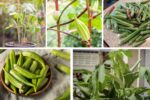If you’re looking to add a flavorful, aromatic herb to your home garden that thrives quickly and offers double the harvest — both fresh leaves and flavorful seeds — cilantro is an excellent choice. Loved for its zesty, citrusy flavor, cilantro is a staple in Mexican, Indian, Thai, and Middle Eastern cuisine. Better yet, it’s an easy-to-grow herb ideal for both beginner and experienced gardeners.
In this comprehensive guide, we’ll walk you through how to start growing cilantro, from choosing the right variety to harvesting and preserving your crop. Let’s get growing!
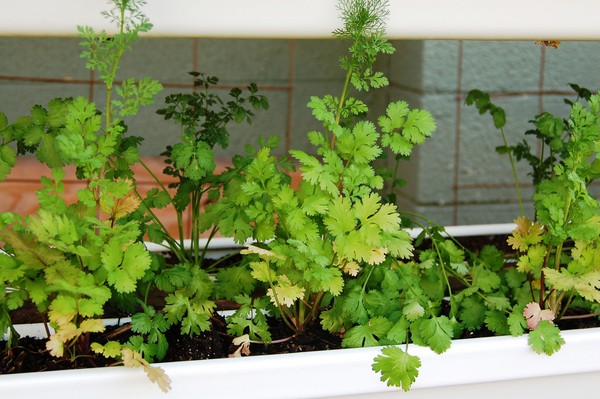
Why Grow Cilantro?
Before we dig into the soil, let’s talk about why cilantro deserves a spot in your herb garden:
- Fast-growing and ready to harvest in as little as 3-4 weeks.
- Grows well in containers, raised beds, or directly in garden soil.
- Provides both edible leaves (cilantro) and spice seeds (coriander).
- Freshly harvested cilantro is far more flavorful than store-bought.
- Attracts beneficial pollinators and repels unwanted pests like aphids.
- Requires minimal maintenance — perfect for beginner gardeners.

Cilantro vs. Coriander: What’s the Difference?
One plant, two names — and two uses!
- Cilantro: Refers to the fresh leaves and stems.
- Coriander: Refers to the plant’s seeds, which have a warm, spicy, citrusy flavor.
In some countries like the UK, the entire plant is called coriander, but in the U.S. and Canada, cilantro means the leaves, and coriander means the seeds.

Best Cilantro Varieties to Grow
While cilantro plants look similar, different varieties offer varying levels of bolt resistance (flowering too early) and flavor. Here are some popular options:
- Santo: A bolt-resistant variety ideal for warmer climates.
- Calypso: One of the slowest-bolting options — perfect for steady leaf harvests.
- Leisure: Fast-growing with good flavor, commonly grown in home gardens.
- Confetti: A unique, finely divided, fern-like leaf variety.
Tip: Choose bolt-resistant varieties if you live in a warmer region to prolong your harvest window.
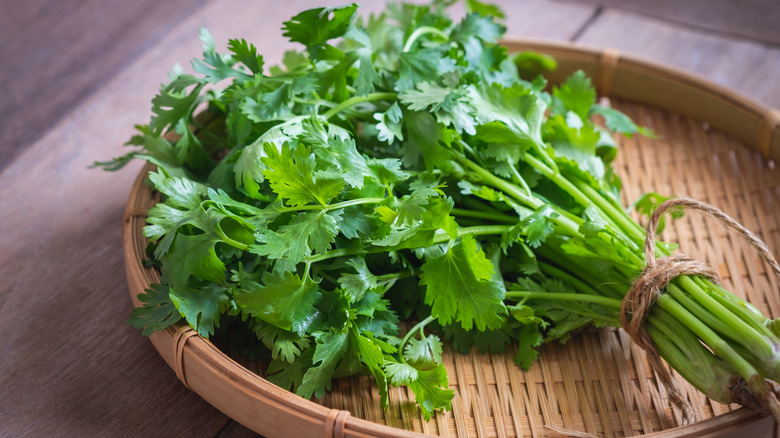
When and Where to Plant Cilantro
Best Time to Plant:
- Outdoors: In early spring or fall when temperatures are between 50°F and 85°F (10°C–29°C).
- Indoors: Year-round on a sunny windowsill or under grow lights.
Cilantro prefers cooler weather and tends to bolt quickly in the heat, making it ideal for shoulder seasons.
Choosing a Location:
- Sunlight: Prefers full sun (6-8 hours) in cooler climates and partial shade in hot areas.
- Soil: Well-draining, loose, and rich in organic matter with a pH of 6.2–6.8.
- Containers: Cilantro thrives in pots at least 8-12 inches deep to accommodate its long taproot.
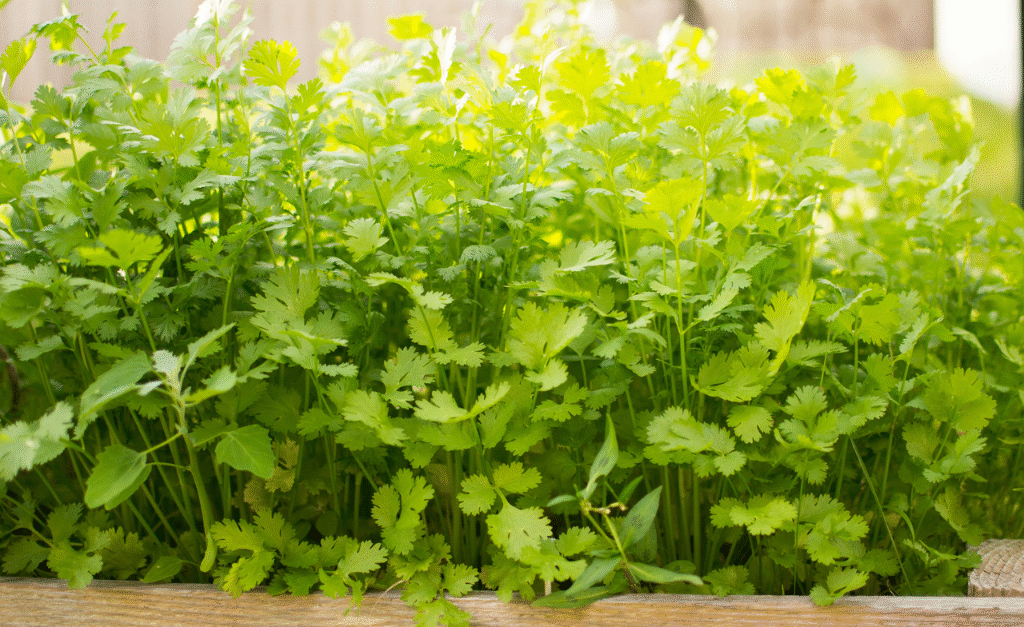
How to Plant Cilantro
From Seeds:
Cilantro is best grown from seed, as it has a delicate taproot that doesn’t transplant well.
Steps:
- Sow seeds directly into soil 1/4 inch deep and 2 inches apart.
- Lightly cover with soil and gently water.
- Keep soil consistently moist but not waterlogged.
- Seeds germinate in 7-10 days.
For continuous harvest, succession plant every 2-3 weeks.
From Transplants:
If you must use nursery starts:
- Handle the roots gently.
- Transplant without disturbing the root ball.
- Water well after planting.
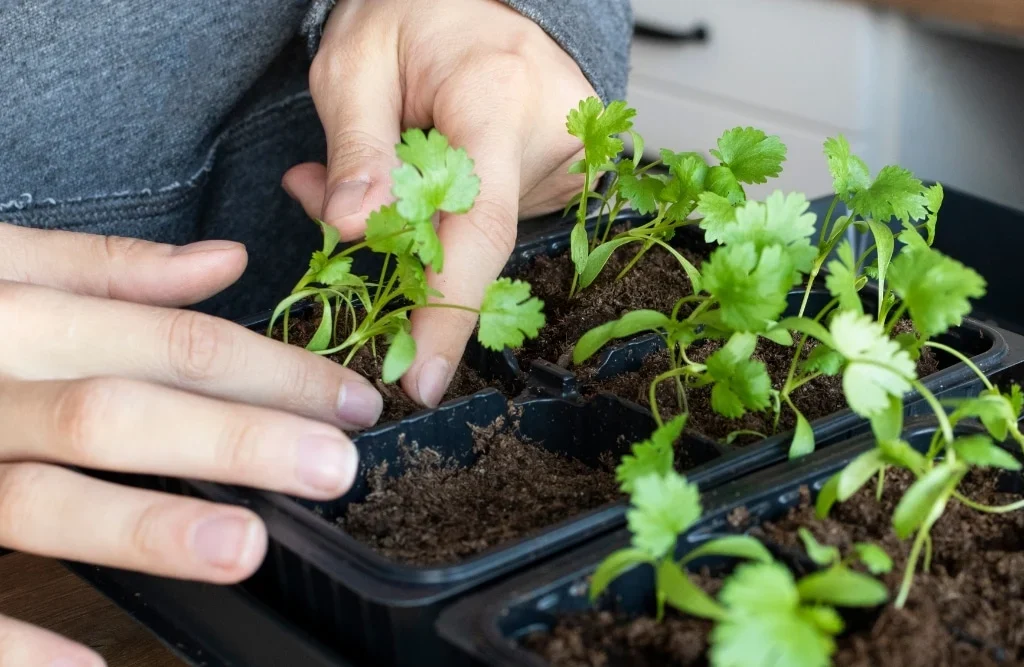
Caring for Cilantro Plants
Cilantro is a low-maintenance herb, but a few simple practices will keep it thriving.
Watering:
- Water deeply when the top inch of soil feels dry.
- Avoid overwatering, which can cause root rot.
- Mulch around plants to retain moisture and suppress weeds.
Fertilizing:
- Cilantro prefers fertile soil — mix compost or organic matter into the soil before planting.
- Apply a balanced liquid fertilizer (10-10-10) once or twice during the growing season if needed.
Thinning:
Once seedlings reach 2 inches tall, thin them to 6 inches apart to allow room for proper growth.
Preventing Cilantro from Bolting
Bolting is when a plant sends up a flower stalk and quickly goes to seed, causing leaves to turn bitter.
How to prevent bolting:
- Plant in cooler months or provide afternoon shade.
- Keep soil consistently moist.
- Choose bolt-resistant varieties.
- Harvest regularly to encourage leaf growth over seed production.
If your cilantro does bolt, let it flower — the tiny white blossoms attract bees and beneficial insects, and you can collect coriander seeds later.
Common Pests and Diseases
Cilantro is relatively hardy but can occasionally encounter pests and diseases.
Pests:
- Aphids: Spray with water or insecticidal soap.
- Leaf miners: Remove affected leaves and use floating row covers.
- Cutworms: Use collars around young plants.
Diseases:
- Powdery mildew: Improve air circulation and avoid overhead watering.
- Damping-off: Prevent by using well-draining soil and avoiding overcrowding.
Harvesting Cilantro
When to Harvest:
- Start harvesting leaves when plants are 4-6 inches tall, typically 3-4 weeks after planting.
- Cut leaves from the outer part of the plant, leaving the inner stems to grow.
Pro Tip: Harvest early in the morning for the best flavor.
How to Harvest Seeds (Coriander):
- Allow plants to flower and form seed heads.
- Once seed heads turn brown and dry, cut them off.
- Hang seed heads upside down in a paper bag to dry.
- Once fully dry, shake seeds loose and store in airtight containers.
Storing and Preserving Cilantro
Cilantro’s fresh flavor fades quickly, but you can store it short-term or preserve it for later use.
Storing Fresh:
- Place stems in a jar of water.
- Cover loosely with a plastic bag.
- Refrigerate for up to a week.
Freezing:
- Chop leaves and freeze in ice cube trays with water or olive oil.
- Use frozen cubes in soups, sauces, and stews.
Drying:
- Cilantro loses much of its flavor when dried, so freezing is the preferred preservation method.
Companion Planting with Cilantro
Cilantro makes an excellent companion plant for several vegetables and herbs.
Good companions:
- Tomatoes
- Peppers
- Spinach
- Beans
- Basil
Its strong scent deters harmful pests like aphids and spider mites, while its flowers attract pollinators and beneficial insects.
Avoid planting near: Fennel, as they can compete for growth.
Pro Tips for Successful Cilantro Growing
- Succession plant every 2-3 weeks for a continuous harvest.
- Thin seedlings early to avoid overcrowding.
- Harvest regularly to delay bolting.
- Keep soil moist but avoid soggy conditions.
- Choose bolt-resistant varieties for summer planting.
Final Thoughts
Growing cilantro is one of the easiest and most rewarding ways to enhance your home garden and kitchen. With its fast growth, minimal maintenance needs, and dual-use harvest of both fresh leaves and seeds, cilantro is a versatile herb that thrives in containers, raised beds, and garden plots alike.
By following this step-by-step guide, you’ll have a steady supply of zesty, aromatic cilantro to use in your favorite dishes — from tacos and curries to salads and sauces. Whether you’re a seasoned gardener or just starting out, cilantro is a flavorful, easy-grow herb you’ll love having at your fingertips.


